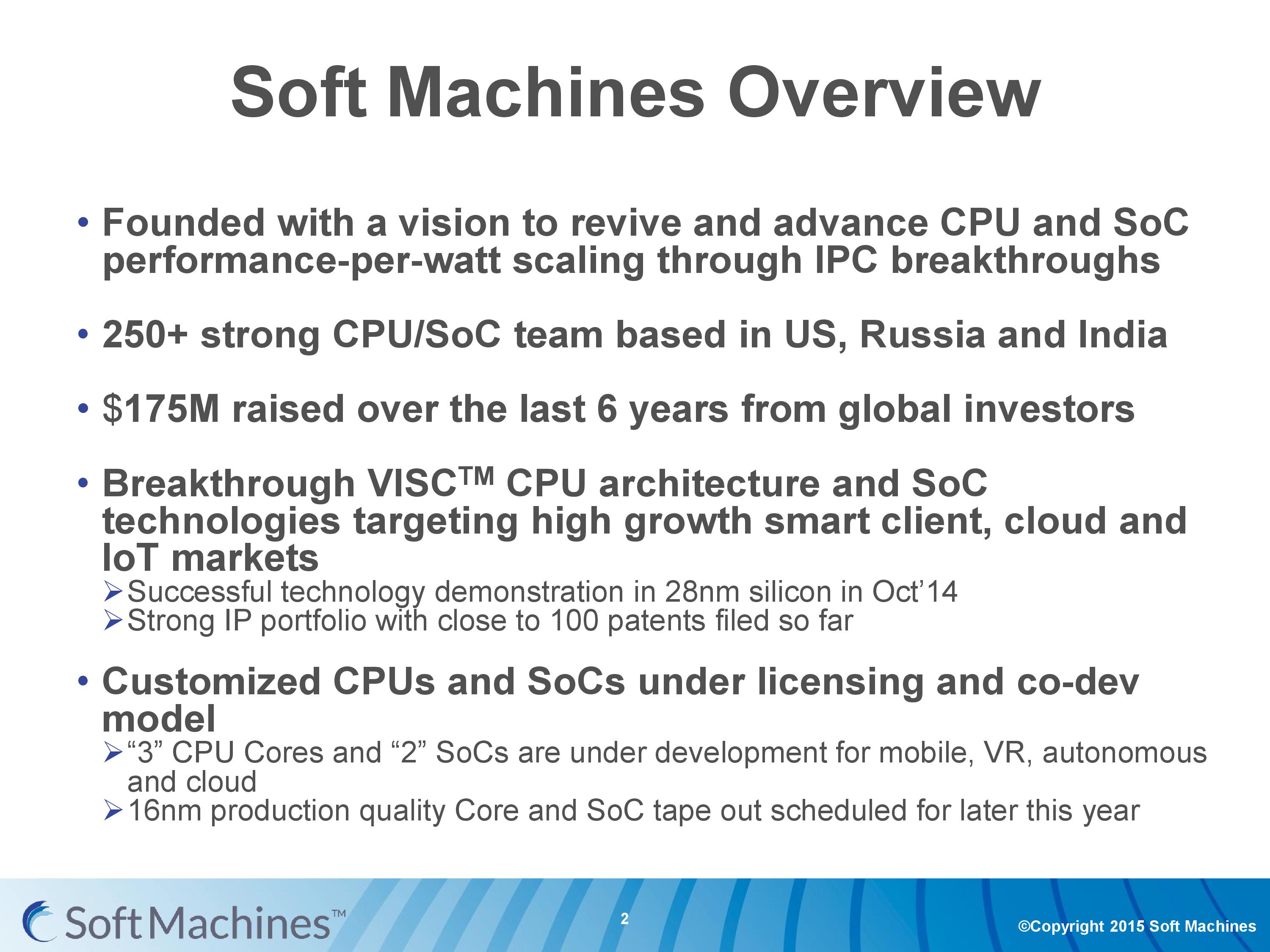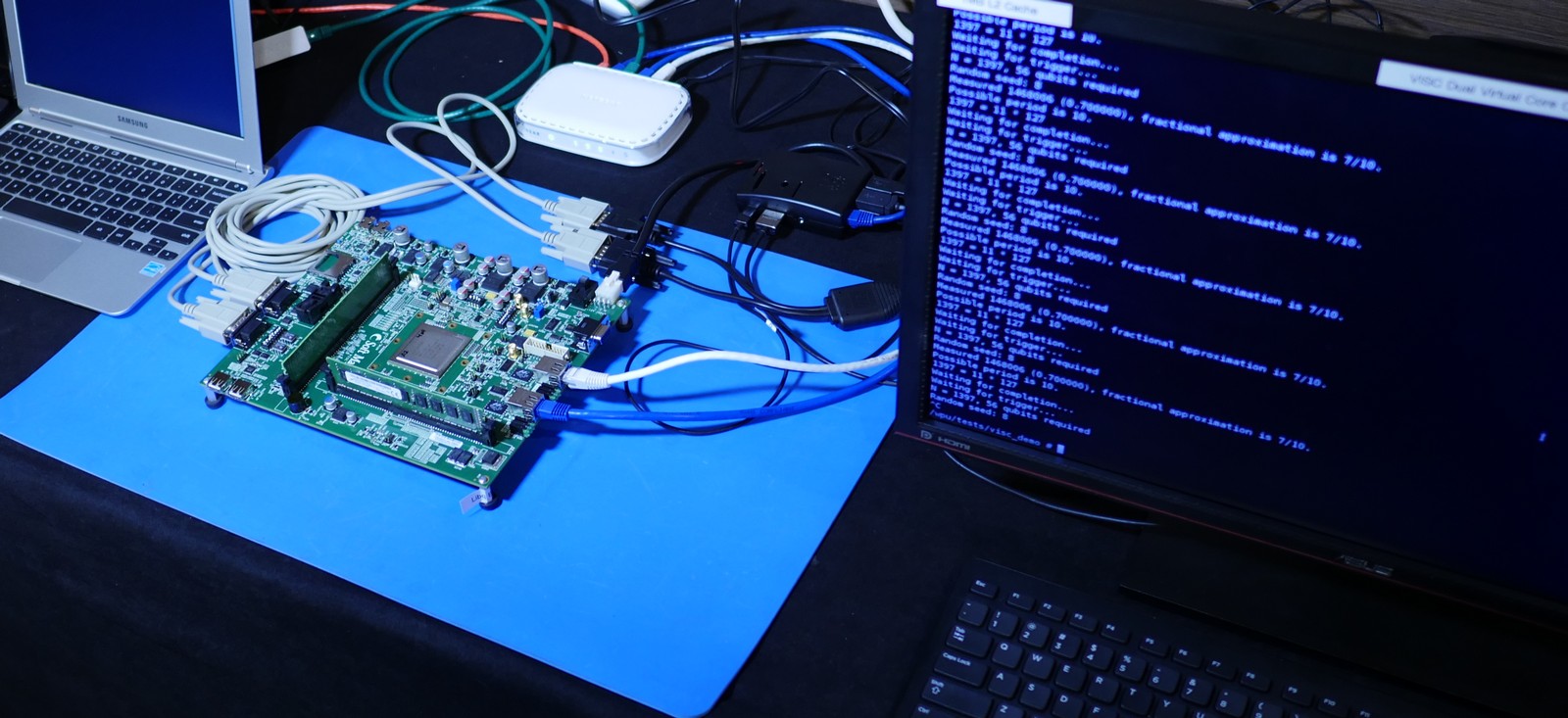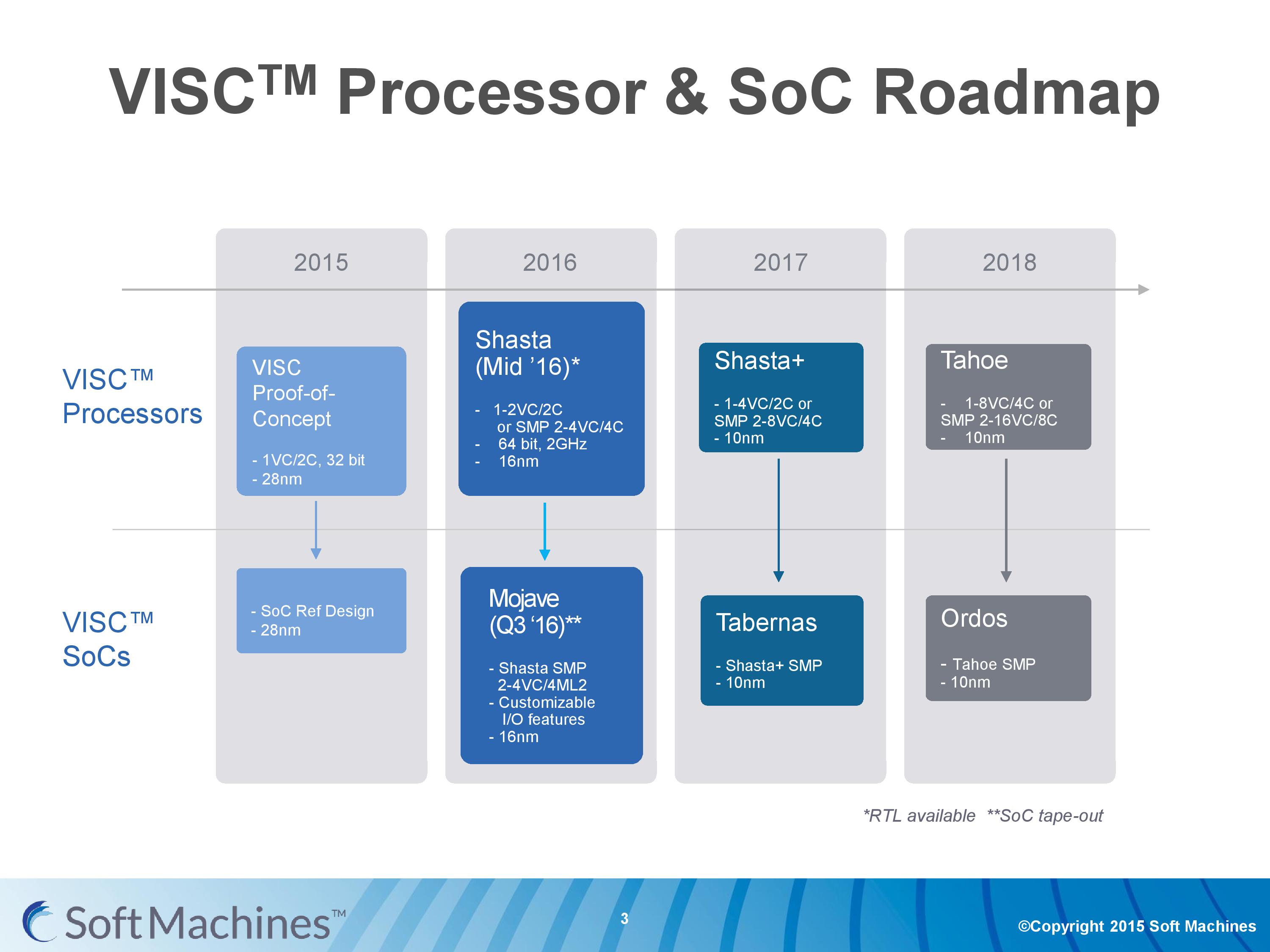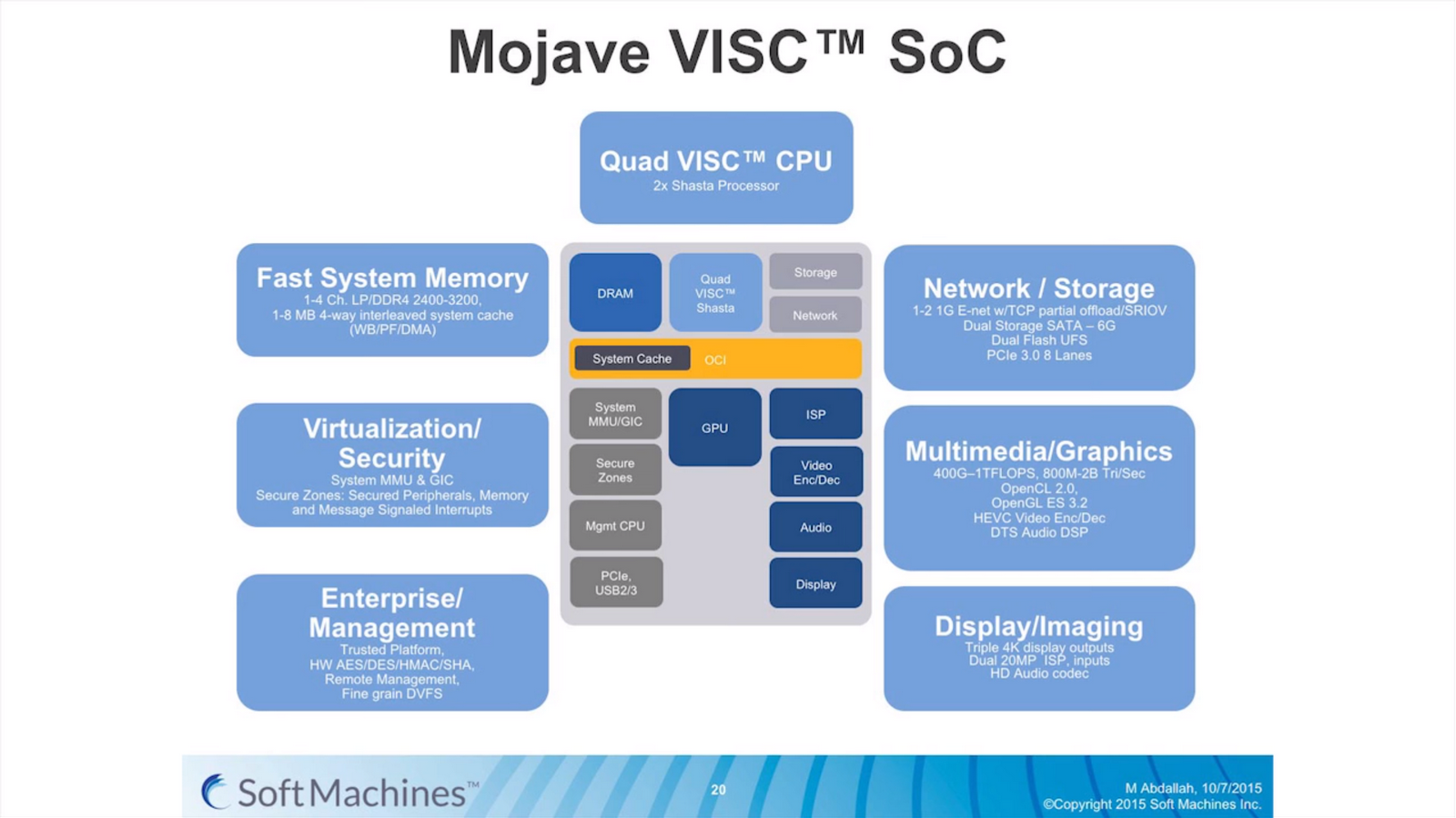Examining Soft Machines' Architecture: An Element of VISC to Improving IPC
by Ian Cutress on February 12, 2016 8:00 AM EST- Posted in
- CPUs
- Arm
- x86
- Architecture
- Soft Machines
- IPC
Soft Machines
To put it succinctly, having a thread take resources from multiple cores - when the performance can be extracted - sounds like the long-desired solution to the problem making multi-core designs more useful in lightly-threaded scenarios. Having multiple threads use resources on a single core on the same clock cycle is an even bigger leap in the same direction. Now obviously Soft Machines didn’t come up with this overnight.
Soft Machines came out of stealth mode at the 2014 Linley Conference. Their main goal was to increase performance-per-watt using better IPC designs, which is often one of the better ways if you can keep a design fed with data. One big challenge to this is that IPC has been somewhat flat these past few years - we're seeing small sub-10% yearly increases from the big players using standard designs. Soft Machines were already six years old at the time, with $150M+ raised from investors that include Samsung Ventures, GlobalFoundries, AMD, Mubadala and others (with another $25M since). If those names all seem interlinked, it’s because they all have historic business or investment dealings with each other (AMD/GloFo, Samsung/GloFo, AMD/Mubadala etc.). The team at Soft Machines is 250+ strong, with ex Intel, ex Qualcomm, ex AMD engineers on staff from processor design to platform architects. Half the staff is currently located in California.
At the 2014 conference, aside from explaining what they were doing, Soft Machines also exhibited working silicon of their design. The first generation proof of concept was fabbed at 28nm at TSMC and running at 500 MHz.
It seems odd to say that it was done at TSMC, especially with Samsung and Global Foundries as investors. We were told that this was due to timing and positioning with IP more than anything else, and the same is true for the next generation at 16nm FF+, rather than 14nm.
VISC and Roadmaps
The first generation chip wasn’t perfect – there were some design flaws in silicon that required specific workarounds relating to cache flushing and various methods, but at the time it was compared to a single thread Cortex A15 running at a similar frequency in a Samsung processor. The results with SPEC2000, SPEC2006, Denbench and Kraken gave a corresponding IPC relative to A15 of 1.5x to 7x, or as Soft Machines likes to put it: 3-4x "on average." It was estimated that access to a second physical core improves performance by an average of 50-60%, or an average IPC of 1.3 per core compared to 0.71 for Cortex A15, which explains the 3-4x average.
The roadmap for Soft Machines put their second generation VISC core, Shasta, in line for 2016. It was formally announced at the 2015 Linley Conference, with this month’s announcement being more about availability for licensing on 16FF+. The Shasta core on this node is designed as a 2C/2VC design, or two of these can be put together using a custom protocol interconnect to form a dual 2C/2VC design.
The custom interconnect fabric here is capable of over 200 GB/s, although in current designs only a single interface is present, allowing only two chips to be connected.
The dual processor design is going to be part of the Mojave IP as a fully integrated SoC.
Along with the requisite VISC cores, the Mojave SoC includes PowerVR graphics, a DDR4 memory controller, virtualization management, a PCIe root complex capable of eight lanes of PCIe 3.0, USB ports, support for SATA, UFS, OpenCL 2.0 and other standards.
Looking forward, Soft Machines would like to see production move to 10nm in 2017 to take advantage of further power and area scaling. Meanwhile along that same timeframe they also want to expand the Shasta design to allow for four virtual cores per two physical cores, essentially allowing more threads to be in flight at one time and fully use the resources better. 2018 sees the move to four physical cores and eight virtual cores per design, while still supporting SMP and SoC designs as well.















97 Comments
View All Comments
vladx - Sunday, February 14, 2016 - link
If it works, Intel or ARM won't be abke to copy them because they've already patented the techniques used.vladx - Sunday, February 14, 2016 - link
*able tovalinor89 - Saturday, February 13, 2016 - link
AMD, Samsung and Globalfoundries are chief investors so it is doubtful Intel or Nvidia will be able to aquire this company.xthetenth - Friday, February 12, 2016 - link
Why is that such a red flag? They show the optimal part of the curve for A72, and they show the suboptimal tail for all of them, although they extend it farther for the A72 to show what it takes to get it up to the same performance level (basically it's non-viable and that they're in a different class if accurate), and they say as much. There's a huge list of objections the article raises and that isn't on it for pretty good reason. It's just not nearly as big a deal as the rest.Andrei Frumusanu - Friday, February 12, 2016 - link
It's incorrect to simply extend a curve of an existing design beyond its design operating range. It's perfectly possible to design the physical implementation to be optimized at very high frequencies - in such a case the curve would less steep but consume higher power at the low frequencies. Extending the curve of a low-power design is relatively misleading in this case.extide - Friday, February 12, 2016 - link
Yeah, and I don't think they should adjust the Intel cores at all. Intel chips come as Intel makes them, that's it. You will never see the skylake arch on TSMC or GF foundry processes. You should take the results from the Intel chip as they are because that is what you will be competing against, not some made up adjusted result that will never exist in the wild.As for adjusting the OTHER chips, well, ok I see what they are going at here, but I still think they took it a bit too far, like adjusting for more or less cache. Although you can see those other chips on various processes, form GF and TSMC, so the process correction isn't really as big of a red flag to me.
name99 - Saturday, February 13, 2016 - link
The curve is not illegitimate because you're missing the point. The goal of the curve is not to show how great their CPU is, it is to show how great their TECHNOLOGY is (ie their microarchitecture). This is best done by comparisons that hold all else equal (ie same process, same compiler, same caches, etc; only different microarchitecture).If you're going to criticize the presentation, criticize it on grounds that actually make sense:
- their "performance" score is garbage because they claim to be in the business of speeding up SINGLE-THREADED code, but then mix in a number of benchmarks that are very naturally parallelized. This is much like comparing an ARMv8 CPU with NEON switched off to an x86 using AVX-512, to test matrix multiplication speed --- it's simply NOT telling you anything about single-threaded performance.
- the robustness of their normalizations is dodgy and they provide little evidence that the ways in which they have normalized are legit.
gamerk2 - Friday, February 12, 2016 - link
This is where CPUs are eventually going to go, since it's really the only way to get maximized CPU performance without adding a lot of power-hungry components onto the die.That being said, the likely outcome is someone (Intel most likely, possibly NVIDIA) acquires Soft Machines and integrates their IP onto their own chips.
vladx - Sunday, February 14, 2016 - link
Doubt it, the only chance for NVidia would be to license it and Intel would most likely be blocked from nuying such a company.Avendit - Friday, February 12, 2016 - link
How doe this all compare to the Transmetta/Crusoe parts? That had a different purpose but did have the translation abstraction layer approach, but didn't seem to go anywhere unfortunetly. Are there any parallels or learnings to be had?